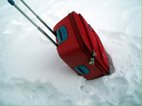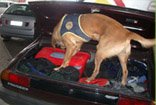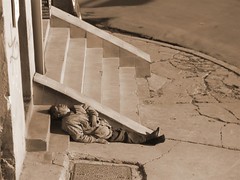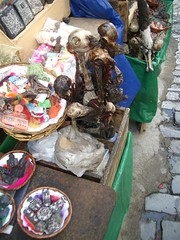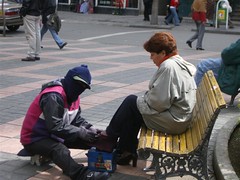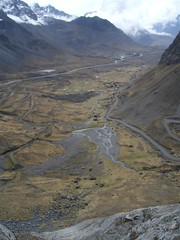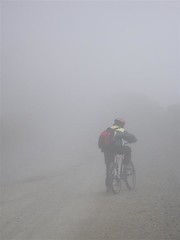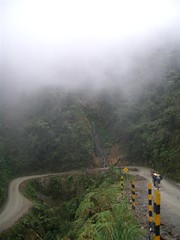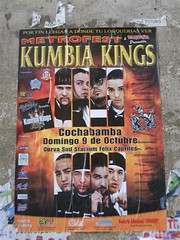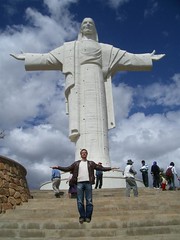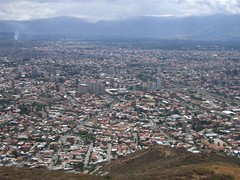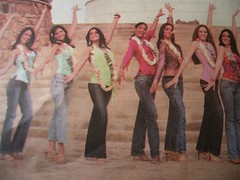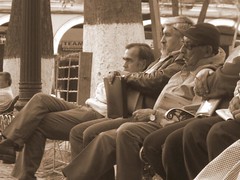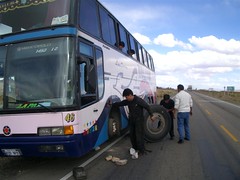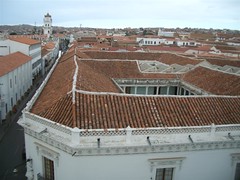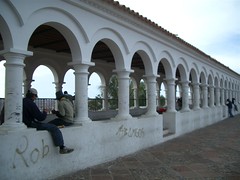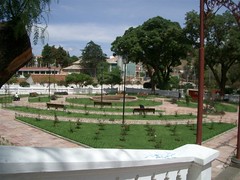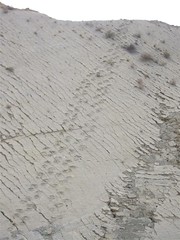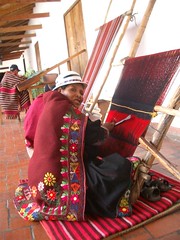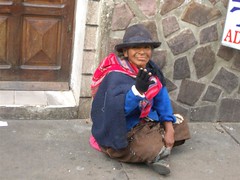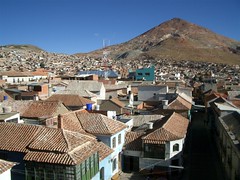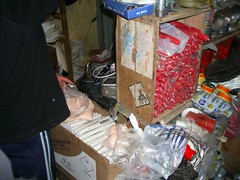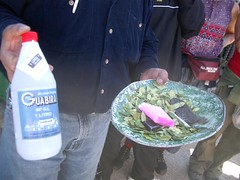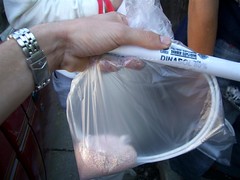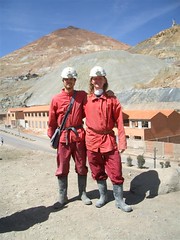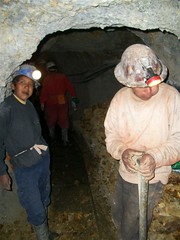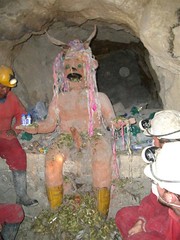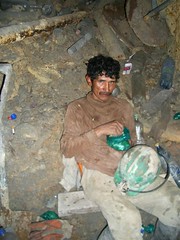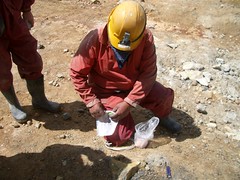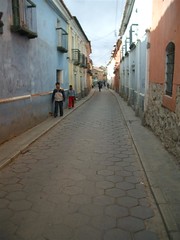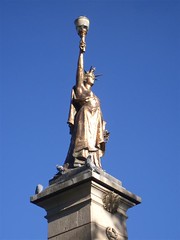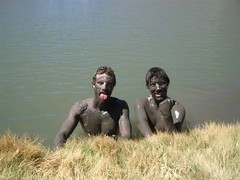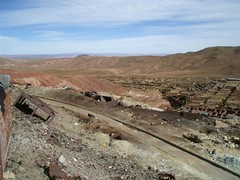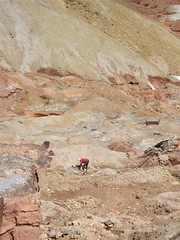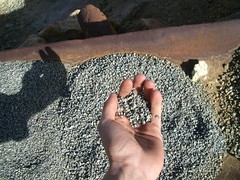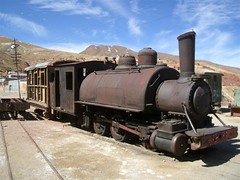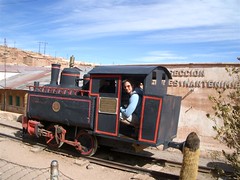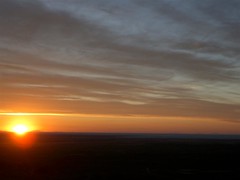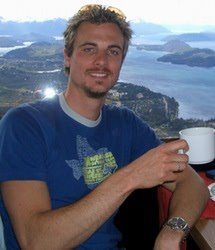53. La Paz (La Paz, Bolivia)
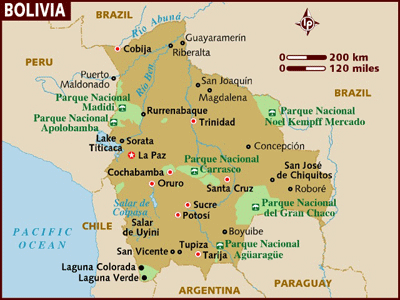
Map stolen from www.lonelyplanet.com
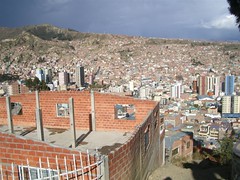
Unfinished buildings line the canyon walls
The next day I got lost yet again and couldn't even find a cafe to have breakfast... argh I had to get out. But I finally found a decent breakfast, and with that under my belt I decided to give La Paz one more chance. The hostel I changed to didn't have any single rooms so I had to sleep in a dorm for the first time since about February. There I met an Irish bloke named Barry and that night he showed me where the gringo bars were (English-run Oliver's Travels, Dutch-run Sol & Luna)... and there I bumped into the same group of ten Irish I'd been hanging out with in Potosi, so all of a sudden La Paz was a lot more comfortable.
In all I spent 5 days in La Paz, I don't think I ever liked it but I became more used to it. I took a tour of the city in an open-roofed double-decker bus which was more like an intimate look at La Paz's low hanging power and phone lines, as they scrapped the windows. They warned us not to stand up during the tour with good reason. We stopped in Valle de La Luna (Moon Valley) which was an area of strange grey moonish rock formations supposedly once visited by Neil Armstrong himself. Valle de La Luna overlooks part of the world's highest golf course, where the ball supposedly flies further due to the thin air.
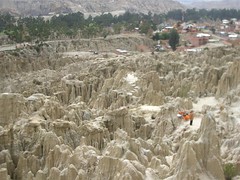
Moon Valley, with a fairway in the background
Another afternoon Barry and I wandered around the downtown area on foot (and got lost). He'd been in La Paz nearly a week but had yet to see any of the city due to his constant partying. We checked out the Witches Market where you can buy ceramic trinkets for your friends as well as dried llama foetuses for your evil stepmother to caste a spell.
The ubiquitous shoeshine boys that are in every South American city hide behind ski-masks in La Paz, because of the shame of being a shoeshiner (or to protect them from toxic shoe-shine?). The only place in South America I've seen them do that.
My final day in La Paz was a long one. I'd signed up to do a downhill mountain bike ride down "The World's Most Dangerous Road", so dubbed by the Inter-American Development Bank in 1995. The road is 64km from La Paz to Coroico, descends 3600m, and is so named for its number of steep cliffs, blind corners and drunk bus drivers. I'd wanted to sign up with one of the agencies from my hotel for US$36 for the day but my Irish friends had already signed up to do it with Gravity Assisted (owned by a Kiwi) for US$50. An expensive day by Bolivian standards, considering the average wage here is US$70 a month. But they'd kit us out with decent Kona downhill bikes with disk brakes, as well as helmet and gloves (but no knee pads).
I'd kind of thought the World's Most Dangerous tag was a bit overrated as I'd met plenty of backpackers along the way who'd done the ride themselves. But then I met an Australian guy who told me the day he did the ride one guy in his group broke a collarbone, another a wrist, and another needed stiches in his knee, so suddenly I wasn't so confident. Especially since I know I have a stupid male competitive streak when it comes to speed (cars, motorbikes). After I'd signed the disclaimer the Gravity guy told me 7 people had died doing the ride in the four years they'd been doing it (with other companies, none with Gravity). So I resigned myself to taking it easy, nice and slow.
7:30am we met at a cafe, before driving an hour or so to La Cumbre, where we were given our bikes and optional rain jackets (for hire). After enough stuffing around adjusting bikes and seats our group of 21 riders was off - with me leading the way (behind the guide). That damn competitive streak. The first third or so of the ride was tarmac so we flew down, passing the odd truck or bus.
Soon enough we were stopping to wait for everyone else to catch up, before setting off again. But everyone kept a pretty quick pace through the tarmac section.
We passed through two military checkpoints which were searching buses for cocaine or chemicals used to create it. Then the tarmac fun stopped as we descended through the clouds with visibility of only about 10 metres, so we had to slow right down. And then the tarmac finished and we were on the unpaved section called the world's most dangerous.
In Bolivia, as in the rest of Latin America, the cars drive on the right hand side. But that changes for the World's Most Dangerous Road, now we (and all the other downhill traffic) changed to driving on the left hand side. That's the cliff hand side, to be sure.
Unfortunately, the cloud cover stayed with us for about the first hour, and turned to rain cover for a while. Well, some said it was fortunate, as it meant we couldn't see the sheer 1000m cliffs we were riding so perilously close to.
As we got lower the weather got clearer and warmer. Now me and a couple of the boys were in full competitive mode, passing when we could. It was actually easier to go faster, as braking made the bike unstable, although I think I was the only one in our group actually doing jumps off the bumps (apart from our guides). That was why I hated following - cos you'd have to brake when the guy in front did, and it felt easier to coast over the ruts rather than brake over them.
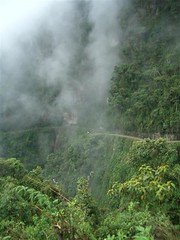
Mist rising from the forest in front of the road
By the very end the road was dry and it was pretty dusty. Our guide Ian warned us that this was when 80% of the accidents happen, because by the end everyone's feeling confident. That didn't stop us in front from pushing it, but we all made it to the end without falling off (or dying).
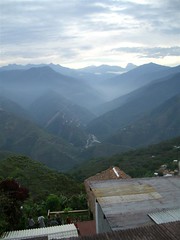
View of the valley from the hotel
With the ride over we celebrated with a beer and then they took us to a hotel/resort in Coroico for lunch and a shower. Some of the group stayed in Coroico, which seemed like a nice village to chill out in, while the rest of us had a 3 hour bus ride back to La Paz. That night I went out partying til 5am so it was a long day! And no muscle aches the next day either, surprisingly. Although I did miss my bus so had to stay in La Paz one more day, albeit most of it in bed.
